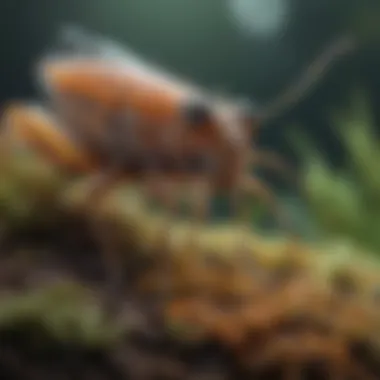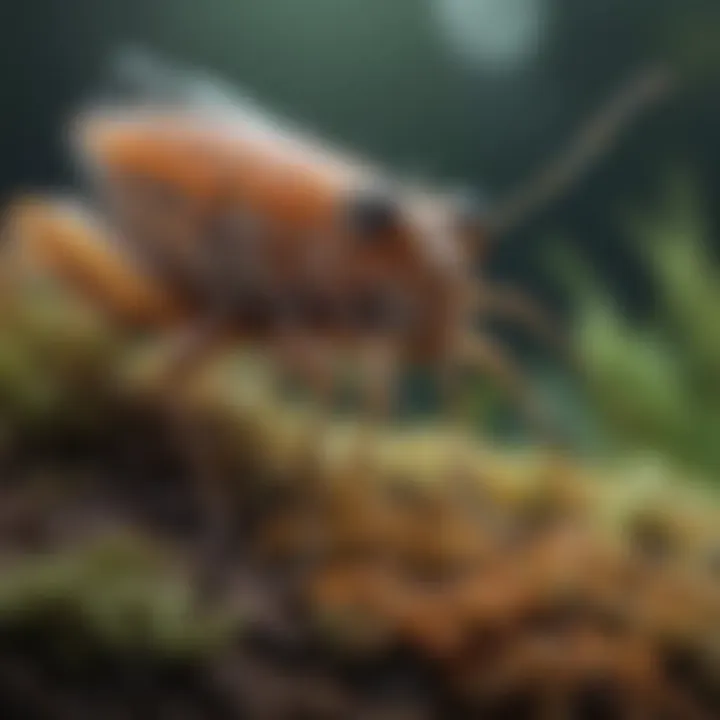Exploring the Miridae Family: Taxonomy and Impact


Intro
The Miridae family, commonly referred to as plant bugs, has attracted significant interest within the scientific community. This interest arises from their diverse roles in ecosystems and their impact on agriculture. Members of the Miridae family exhibit considerable variation in morphology and behavior, making their study essential for understanding ecological interactions and pest management strategies.
The understanding of the plant bugs is not just limited to their biological features. The role of Miridae in agriculture is complicated. While some species are considered pests that can cause substantial damage to crops, others serve beneficial roles in maintaining ecological balance. The duality of their impact necessitates a holistic approach to study and management.
In this comprehensive article, we aim to dissect the multiple facets of the Miridae family. From taxonomy to their ecological significance, we will cover key themes that underline their importance in both natural and agricultural systems.
Prelude to Miridae
Understanding the Miridae family, commonly referred to as plant bugs, plays a crucial role in comprehending the broader ecological and agricultural systems. This family encompasses a multitude of species that have significant interactions with various plants, affecting both ecosystems and human interests. The importance of the study of Miridae extends beyond mere biodiversity; it includes their role as pests in agriculture, as well as their potential benefits in natural pest control and pollination.
Miridae are interesting due to their diverse morphologies and behaviors. The family includes small to medium-sized insects with a distinct body shape and coloration. Their adaptability to different habitats makes them a study subject in various ecological inquiries. Researchers find their behaviors notable, especially in how they interact with plants.
Examining Miridae allows for a more profound understanding of ecological roles they play. Their presence can signify plant health or stress, serving as indicators for agricultural practices. Additionally, they contribute to the complex food webs within ecosystems, supporting various predatory and parasitic relationships. This indicates their ecological importance goes far beyond being mere pests.
The focus on Miridae is not also a matter of ecological balance; it also carries economic significance. Many species are recognized for causing damage to crops, influencing pest management strategies in sustainable agriculture. Understanding the biology and habits of these insects can lead to better control methods that reduce chemical pesticide reliance.
"Understanding both the advantageous and detrimental aspects of Miridae can lead to sustainable agricultural practices and healthier ecosystems."
Investing time in studying this family is essential for researchers, educators, and professionals alike. It enhances our appreciation of biological diversity and its significance in practical terms. Through detailed exploration, this article seeks to provide a deeper understanding of Miridae and their multifaceted roles in our world.
Taxonomy of Miridae
The taxonomy of the Miridae family is crucial for understanding the diversity and classification of plant bugs. Taxonomy aids in organizing biological knowledge, thus facilitating research and conservation efforts. By clearly delineating relationships and characteristics of various species, researchers can study their ecological roles and interactions more effectively. Furthermore, accurate classification can lead to better pest management strategies in agriculture, hence highlighting its economic significance.
Classification Hierarchy
The classification hierarchy of the Miridae family follows a structured format, as shown below:
- Kingdom: Animalia
- Phylum: Arthropoda
- Class: Insecta
- Order: Hemiptera
- Family: Miridae
Within this framework, Miridae is subdivided into several subfamilies, tribes, and genera. The precise classification helps clarify the evolutionary pathways and enable more focused ecological studies. Each level of this hierarchy plays a pivotal role in dissecting the vast diversity in morphology and behavior that defines the Miridae family. Understanding these classifications can assist in identifying specific species and their environmental adaptations.
Key Characteristics
Miridae exhibits several key characteristics that distinguish them from other insect families.
- Body Structure: Members of this family typically have a flattened body shape. This adaptation aids in their herbivorous lifestyle, allowing them to navigate through foliage.
- Antennae: They usually possess long and slender antennae, which are often longer than their bodies. These sensors are crucial for detecting environmental cues and potential mates.
- Wings: Many species have variations in wing structure, influencing their ability to disperse and escape predators.
Furthermore, the instar stages of nymphs can show distinct traits, which helps in identification. Understanding these characteristics not only enhances field observations but also informs research in pest management.
Notable Genera and Species
The Miridae family encompasses a wide range of genera and species. Some notable examples include:
- Lygus: Known as tarnished plant bugs, this genus is notorious for its role as a pest in various crops.
- Phytocoris: Generally found on plants, species in this genus often engage in predatory behavior, helping control pest populations.
- Dicyphus: Notable for their use in biological control, certain members of this genus are beneficial insects in greenhouse environments.
Each of these genera has unique traits and ecological functions, making them a point of interest for researchers examining interactions within ecosystems. Understanding these genera contributes to a greater appreciation of biodiversity and the importance of the Miridae family in various environments.
Biology of Miridae
The biology of the Miridae family is fundamental in understanding their ecological roles and economic significance. This family is diverse, with various species exhibiting unique attributes. The detailed study of their biological aspects allows for better management and conservation strategies. In this article, we will explore the morphology, life cycle, and feeding habits of Miridae, providing insights into their adaptations and interactions within ecosystems.
Morphological Features
Understanding the morphological features of Miridae is essential for identification and classification. Members of this family typically range from 1 to 10 mm in length, characterized by elongated bodies which can be flat or slightly rounded. The surface may have various textures, including smooth, hairy, or spiny.


Their most distinguishing attribute is the structure of their mouthparts. Mirids possess piercing-sucking mouthparts, allowing them to feed effectively on plant sap.
Key morphological elements include:
- Antennae: Usually long and segmented, providing sensory functions.
- Wings: Many species have two pairs of wings, with the front pair being membranous and the hind pair being more reduced.
- Legs: Adapted for jumping, their legs facilitate movement, aiding in their feeding and escape from predators.
Life Cycle and Development
The life cycle of Miridae is intriguing and vital for grasping their impacts on agriculture and ecosystems. Typically, these insects undergo incomplete metamorphosis, consisting of three stages: egg, nymph, and adult.
- Egg Stage:
- Nymph Stage:
- Adult Stage:
- Females lay eggs on or near host plants. The eggs are often elongated and vary in color, usually blending with the foliage. Occasionally, females may exhibit parental behavior by guarding the egg clusters.
- Nymphs emerge from eggs after a few days. They have a similar body form as adults but lack wings. This stage may undergo several molts before reaching maturity. Development time varies with environmental conditions, often taking several weeks.
- Adults are fully developed and reach reproductive maturity. The ability to reproduce and disperse quickly allows them to adapt rapidly to changing environments.
The knowledge of their life cycle aids in understanding their population dynamics and potential impacts on agriculture.
Feeding Habits
Miridae are primarily herbivorous, with a diet mainly consisting of plant sap. They are equipped with specialized mouthparts to pierce plant tissues and extract nutrients. Feeding habits have significant implications for plant health and agriculture.
- Feeding Mechanism:
- Host Plants:
- Nutritional Impacts:
- They insert their mouthparts into plant tissues, drawing out sap while injecting saliva. Salivary enzymes aid in digesting plant materials.
- Miridae feed on a wide range of plants, including crops and native flora. Some species are considered pests due to their feeding on economically important plants, impacting crop yields.
- Their feeding can lead to reduced plant vigor, wilting, and in severe cases, plant death. Some Miridae can also serve as vectors for plant pathogens, exacerbating agricultural issues.
The study of Miridae feeding habits is critical for developing integrated pest management strategies and ensuring sustainable agricultural practices.
Ecological Role of Miridae
Understanding the ecological role of the Miridae family, or plant bugs, is crucial. These insects play significant functions within environments, acting both as agents of pest regulation and participants in pollination processes. With around 10,000 described species, their interactions in ecosystems are diverse and multifaceted, influencing plant health and biodiversity. Their role extends from supporting food webs to affecting agricultural sustainability.
Interactions with Ecosystems
Miridae interact with both plants and other organisms. They contribute to the health of their habitats in several ways:
- Herbivory: As herbivores, they feed on various plant species. This can help control dominant plant growth, allowing other species to thrive, thus promoting plant diversity.
- Nutrient Cycling: The feeding habits of Miridae can aid in breaking down plant matter, facilitating nutrient cycling within the ecosystem. Their excretions contribute organic matter to the soil, enhancing its fertility.
- Food Source: Miridae serve as prey for several predators, including birds, spiders, and other insects. This positions them as an integral part of food webs.
Each of these interactions illustrates the complexity of their role within various ecosystems.
Role as Pollinators
While primarily known as herbivores, some Miridae species also engage in pollination. Their movements between plants can transfer pollen, aiding in fertilization. Pollination by Miridae is less studied than other insects, but it has potential implications:
- Plant Reproduction: Through their activity, they can enhance plant reproductive success, influencing overall population dynamics.
- Diversity of Pollinators: Their role as pollinators adds to the variety of species that support plant reproduction, crucial in maintaining ecological balance.
- Agricultural Impact: In crops, Miridae might facilitate better fruit and seed formation, indirectly increasing yields. This aspect merits further study into their potential as a natural pollinator alternative.
Predation and Prey Dynamics
The dynamics of predation involving Miridae further underscores their ecological significance. Like many insects, they exist in a balance within food webs:
- Predator of Pests: Some Miridae species feed on other pests, providing biological control. They can reduce populations of harmful insects, thus supporting agriculture without the need for chemical interventions.
- Resource Competition: Their presence in an ecosystem can affect the populations of other herbivores, showcasing competition for resources and food. This balance can influence the species composition of plant communities.
- Adaptation and Resilience: Changes in the abundance of Miridae can signal shifts in ecosystem health. Understanding their role can help in conserving ecosystems and mitigating the impacts of climate change.


"The ecological interactions of Miridae reflect a delicate balance essential for maintaining health in their environments. Their diverse roles highlight the interconnectedness of species and their functions in ecosystems."
In summary, the ecological role of the Miridae family is complex and vital. Their interactions with various elements within ecosystems emphasize the importance of studying these organisms further. Insights gained can influence conservation efforts and sustainable agricultural practices.
Economic Importance of Miridae
The economic significance of the Miridae family extends beyond mere curiosity. These plant bugs, though often overlooked, have role that can both positively and negatively impact agriculture and ecosystems. Understanding their economic importance involves examining their influences in various sectors, including agriculture, biological pest control, and market trends.
Impact on Agriculture
Miridae can significantly affect agricultural productivity. Some species, such as Lygus hesperus, are known pests that damage crops like cotton, alfalfa, and strawberries. The feeding habits of these bugs can lead to substantial yield losses. For instance, their piercing and sucking mouthparts damage plant tissues, causing discoloration, wilting, and growth abnormalities. Farmers have to invest in pest management strategies and crop rotations to mitigate these effects.
Conversely, not all Miridae are detrimental. Several species are beneficial, acting as herbivores on weeds, which can have a positive impact on crop health. This duality raises the need for a balanced understanding of Miridae’s role in agriculture: both as pests and as potential allies in managing problematic species. Thus, their economic importance lies in both their capacity to harm and help agricultural practices.
Role in Biological Control
The Miridae family plays a vital role in biological control, which is the use of natural predators or parasites to manage pest populations. Some Miridae species feed on other insects, including aphids and small caterpillars. This predatory behavior helps to keep these pest populations in check, reducing the need for chemical pesticides. The application of biological control is a sustainable approach that farmers can adopt to enhance crop health and yield.
The potential for utilizing Miridae in integrated pest management programs is notable. Research has indicated that promoting beneficial Miridae populations can reduce reliance on synthetic pesticides, leading to more environmentally-friendly agricultural practices. Their predatory nature ensures that they can be integrated into various cropping systems, making them valuable allies in the fight against agricultural pests.
Market Significance
The market significance of Miridae is evident when considering their role in organic farming and sustainable agriculture. As more consumers seek organic products, a demand arises for pest management solutions that do not rely on harmful chemicals. This trend enhances the market value for practices that utilize natural pest predators like Miridae.
Furthermore, the research on Miridae contributes to the scientific market in biocontrol products. These products aim to capitalize on the strengths of beneficial Miridae, leading to developments that can be monetized in agricultural sectors. Here, academic research translates into practical applications, which can yield significant economic returns.
"The integration of beneficial Miridae in pest management not only ensures sustainable farming practices but also enhances crop marketability in the organic sphere."
Methods of Identification
Understanding the Methods of Identification for the Miridae family is critical for researchers and professionals involved in entomology and agriculture. Accurate identification ensures effective management of plant-bug populations and aids in studying their ecological roles and economic impacts. Employing diverse identification techniques allows researchers to classify species reliably and understand their behavior, interactions, and roles within ecosystems.
Morphological Identification Techniques
Morphological identification relies on the examination of physical characteristics. This includes size, shape, color, and structure of body parts. Key features evaluated include the wings, legs, antennae, and genitalia.
- Visual Observation: Using a magnifying glass or microscope to observe specimens in detail.
- Taxonomic Keys: Utilizing dichotomous keys to identify species based on observable traits.
- Color Patterns: Documenting various colorations that differentiate genera or species.
Morphological methods can be time-consuming, but they provide fundamental data essential for understanding species variation.
Molecular Methods
Molecular methods have gained significance in identifying Miridae species more accurately. These techniques utilize genetic material, which helps ascertain relationships that may not be visible morphologically.
- DNA Barcoding: This technique involves analyzing a short genetic sequence from a standard part of the genome, usually mitochondrial, to identify species.
- Phylogenetic Analyses: Analyzing genetic sequences to understand evolutionary relationships and species differentiation.
Molecular techniques are especially valuable when morphological differences are subtle or when dealing with cryptic species.
Field Surveys and Sampling Techniques
Field surveys and sampling techniques are essential for gathering information on Miridae populations in their natural habitats. Different methods include:
- Pitfall Traps: Employing traps set at ground level to capture specimens that walk on the ground.
- Sweeping Nets: Using nets to collect bugs from vegetation by sweeping through plant canopies.
- Light Traps: Leveraging lights to attract nocturnal species for easier collection and observation.
These techniques are crucial for assessing biodiversity, host plant interactions, and population density while aiding in conservation efforts.
Conservation and Threats


The discussion surrounding conservation and threats is vital not only for understanding the Miridae family but also for comprehending the larger implications of biodiversity. Plant bugs, as members of the Miridae family, play significant roles in ecosystems. Their conservation ensures ecological balance and promotes healthy agricultural practices. Addressing threats such as habitat loss and climate change is critical because it directly affects their populations and, by extension, the stability of the environments they inhabit. Understanding these challenges enables us to take informed action to protect both the species and their habitats.
Habitat Loss and Change
Habitat loss is one of the most significant threats facing the Miridae family. Urban development, agriculture, and deforestation are primary contributors to this issue. As natural habitats are converted for human use, the niches that plant bugs occupy disappear, leading to population declines. The fragmentation of habitats limits their ability to move between areas to find food and mates, which can lead to reduced genetic diversity.
Additionally, changes in land use can alter the flora present in these environments. Since Miridae are often closely associated with specific plant species, any changes can severely impact their survival. Insecticides and pesticides used in agriculture further exacerbate the problem by not only impacting target pests but also harming beneficial insects like plant bugs. These factors converge to threaten not just the Miridae family but also the broader ecosystem that depends on their presence.
Effects of Climate Change
Climate change introduces a range of challenges that impact the Miridae family. Rising temperatures, altered rainfall patterns, and increased frequency of extreme weather events disrupt the life cycles of many organisms, including plant bugs. For example, if temperatures rise too quickly, it can affect their development rates and reproductive success.
Moreover, climate change can also shift the geographic distribution of plant species that Miridae rely on for food. As these host plants move or adapt to changing climate conditions, the Miridae may find it difficult to locate suitable habitats. Increased incidences of drought or flooding can similarly affect their populations, leading to potential declines.
In many cases, climate change creates a domino effect, where harm to one species leads to cascading effects through the food web. Addressing climate change is therefore crucial for the survival of the Miridae family and their associated ecosystems.
Conservation Strategies
Effective conservation strategies are necessary for protecting the Miridae family. Some approaches include:
- Habitat Restoration: Rehabilitating damaged ecosystems can help restore populations of plant bugs and their host plants. Native planting efforts can be particularly beneficial.
- Pesticide Regulation: Implementing stricter guidelines for pesticide use can reduce the harmful effects on non-target species, including Miridae.
- Monitoring Programs: Establishing long-term monitoring programs can help track changes in Miridae populations and their habitats, providing valuable data to inform further conservation efforts.
- Community Engagement: Involving local communities in conservation efforts enhances awareness and fosters stewardship. Educational programs about the ecological roles of plant bugs can encourage sustainable practices.
"Conservation of the Miridae family is not just about saving a group of insects; it is about protecting the intricate web of life that sustains our ecosystems."
By employing these strategies and understanding the pressing threats faced by the Miridae family, we can work toward ensuring their survival for future generations. This knowledge not only benefits these insects but also supports the health of our planet.
Research and Future Directions
Understanding the Miridae family is crucial for a breadth of scientific fields, from agriculture to ecology. Current research has provided substantial insights, yet many avenues remain unexplored. Trends indicate a focus on the ecological roles and adaptive strategies of plant bugs, often highlighting their impact on ecosystem dynamics. Future directions aim for deeper investigations into genetic diversity and environmental resilience. As many species face habitat changes, investigating their adaptability is vital for conservation efforts and biodiversity preservation.
Current Research Trends
Research has shifted toward several key areas concerning the Miridae family. The following themes are prominent in recent studies:
- Ecological interactions: How mirids interact within their ecosystems is gaining attention. The role of plant bugs in food webs, specifically their relationships with predators and pollinators, is crucial.
- Genetic studies: New techniques in molecular biology are enabling researchers to explore the genetic makeup of Miridae. Understanding sibling species and genetic diversity is critical.
- Climate change impacts: Studies assess how climatic shifts affect mirid distribution, behavior, and life cycles. This area is particularly relevant in the context of changing agricultural practices.
- Integrated pest management: Exploring the pest status of certain Miridae species encourages research on their potential as biological control agents. This emphasizes their significance in sustainable agriculture.
Future Research Horizons
Several future research opportunities are promising for expanding knowledge of the Miridae family:
- Adaptive physiology: Investigating the physiological adaptations that allow Miridae to thrive across diverse environments is essential.
- Habitat modeling: Advanced modeling techniques can predict how habitat loss and fragmentation impact the distribution and survival of mirid species.
- Multi-trophic interactions: Studying interactions between Miridae, plants, and higher trophic levels can reveal the complexity of ecological networks, as well as the resilience of ecosystems.
- Exploring uncharted territories: Many regions remain under-explored. Focusing on lesser-known habitats could reveal new species or behaviors, thus enriching our understanding.
Collaborative Research Opportunities
Collaboration among scientists is vital in advancing the study of the Miridae family. Several pathways exist for fostering such collaborations:
- Interdisciplinary projects: Combining entomology with ecology, genetics, and environmental science facilitates comprehensive studies that yield richer results.
- Global networks: Engaging with researchers worldwide can lead to the sharing of data, resources, and expertise, promoting a holistic understanding of plant bugs.
- Citizen science initiatives: Encouraging the public to participate in data collection can provide large datasets that enhance research on distribution and population dynamics.
It is through collaborative efforts that we can unravel the complexities of the Miridae family and address the challenges they face in a rapidly changing world.
By exploring these aspects, we can ensure the future research about the Miridae family is impactful, relevant, and beneficial for educational and applied sciences.
Epilogue
In summarizing the intricate world of the Miridae family, it is essential to reflect on their significance within broader ecological and economic frameworks. This article has provided a thorough examination of various aspects, from taxonomy to conservation, revealing the multifaceted roles these organisms play.
Understanding the biological characteristics and ecological interactions of Miridae contributes to greater knowledge of biodiversity. As plant bugs interact with their environment, they influence plant health and ecosystem dynamics. Be it through their predation of pests or their participation in nutrient cycles, Miridae manifest as both beneficial and complex organisms.
The economic importance, particularly in agriculture, cannot be overstated. Miridae species often serve as natural agents for pest control, reducing the reliance on harmful chemical pesticides. Their ability to balance pest populations makes them invaluable assets for sustainable farming practices. Moreover, recognizing their role in pollination elucidates their contribution to crop production and overall food security.
Additionally, this exploration highlights crucial conservation concerns. With habitat loss and climate change presenting significant threats to their populations, proactive conservation strategies must be considered. Effective measures can help preserve both the biodiversity found within the Miridae family and the essential ecological functions they serve.
Finally, further research is paramount. As new techniques and technologies emerge, they allow for a deeper understanding of these insects. Collaborative efforts among researchers, educators, and policymakers can create a foundation for future studies, enhancing our grasp of Miridae’s roles within ecosystems.







